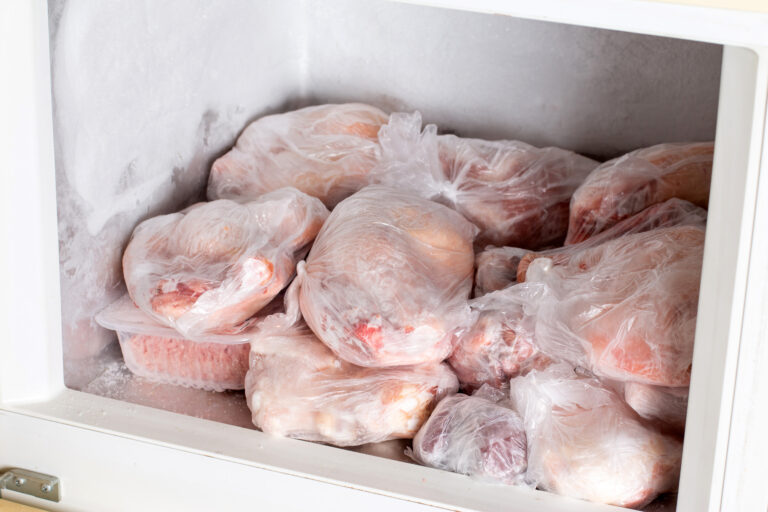There is a right and wrong way to defrost chicken. If you’re anything like me, it's likely your parents took the frozen chicken out before work and let it defrost on the counter during the day. Consequently, you grew up thinking that was the ideal way to defrost chicken. While it might seem like the most efficient method, letting your chicken defrost on the counter (especially in the sun) could leave you exposed to some nasty food-borne illnesses like salmonella and E.coli.
How to safely defrost chicken
To safely defrost your chicken, keep the temperature below 4.4°C. Anything over, and it's in the danger zone, increasing the risk of bacterial growth and foodborne illness.
The safest method: defrosting in the fridge
Thawing poultry in the fridge is the safest method, as it keeps the chicken cool while defrosting. When chicken is warm, it becomes a breeding ground for bad bacteria and increases your risk of exposure to food-borne illness.
However, it does require a few days of advance planning. Some larger pieces of chicken can take longer than 24 hours to defrost, so if you’re short on time and want chicken for dinner, we’d recommend choosing a different method. While 500g packs of chicken thighs, breasts, and minced chicken can take about 24 hours, a whole bird or any bulk pack of chicken could take up to 2 days.
Your chicken should be placed on either a lipped plate, bowl or container on the bottom shelf of your fridge. That way if your chicken ends up leaking, it won’t spoil any ripening fruit or ready-to-eat foods with raw chicken juices. We’d also recommend moving your chicken to the back portion of your fridge, where the temperature is more consistent and your chicken can defrost evenly.
Once your chicken is defrosted, it’ll keep in the fridge for up to 24 hours – then you’ll need to decide whether you’re using it or tossing it.
The most reliable method: defrosting in water
While frozen chicken can be thawed on the counter, it has to be in the appropriate environment. Depending on how you store your frozen chicken, it can be thawed in vacuum-sealed bags, zipper-top storage bags, or freezer bags. Simply submerge your bagged chicken in a bowl of cold water (21°C or lower) on the counter, and change the water every 30 minutes to ensure it stays cold.
Do not use hot or warm water – not only will it begin to cook the meat, but it creates an environment that causes bacteria to multiply. While it's easy to think warm water will defrost the chicken faster, that's not actually true. Both cold and hot water are warmer than frozen chicken, so it will defrost your chicken at the same speed.
If your tap water is not cold enough (a common occurrence during Australian summers!) you can bring the temperature down by chucking in a few ice cubes. Using this method, mince chicken should defrost in about an hour, a few small chicken breasts or thighs in two hours, and larger cuts of meat in three hours. We don’t recommend it for whole chickens or big cuts of meat.
Ensure the bowl you used to defrost the chicken is thoroughly cleaned after your chicken has finished defrosting. Raw chicken water is not something you want to be consuming!
Once the chicken is thawed, cook it straight away.

The last resort: defrosting in the microwave
If there really is no other option and you absolutely need to have chicken for dinner, your last resort is the microwave method.
Most modern microwaves have a programmed chicken defrost setting, so you can quickly defrost your chicken with some extra attention. Pop your frozen chicken in a microwave-safe bowl or container, and set it to defrost for a couple of minutes. Flip it and monitor its progress periodically to ensure it’s evenly defrosted. You’re not going to get a perfectly even defrost, especially since the thinner parts of the chicken will begin to cook before the rest of the chicken is defrosted.
This method isn’t the most reliable, but it's a quick fix if there’s no other option. We’d only suggest this method for chicken that’s going to be shredded or put in a soup, rather than a chicken Kyiv or parmigiana.
After defrosting, cook your chicken immediately and ensure the microwave is cleaned well.
Cooking from frozen
While it’s highly dependent on what you’re cooking, it is completely safe to cook frozen chicken without defrosting it. Some cooking methods, like a long, slow braise or a stew can even turn out better with unthawed chicken. Other methods like roasting and sauteing can yield unevenly cooked chicken with an unpleasant texture.
There are some instances where you can just toss your frozen chicken in the pan and end up with a similar result, like in a stew. But if you want that beautiful, golden crust on your piece of frozen chicken, you’re out of luck. Your frozen chicken releases moisture as it defrosts in the pan, preventing that caramelised goodness you get from thawed chicken.
You can also cook your frozen chicken in a pressure cooker, but steer clear of slow cooking as it creates the perfect environment for bacteria to thrive. The general rule of thumb is simply adding 50% to the cooking time, so if your recipe calls for 60 minutes of stewing time, increase it to 90.
Given the chicken reaches an internal temperature of 74°C, your frozen chicken is safe to eat without defrosting.
General food safety tips
Knowing the food safety basics will help to reduce your risk of foodborne illness.
- Microorganisms from raw meat, poultry, seafood, and eggs can spread to fruits, vegetables and cooked foods unless kept separate. Use separate chopping boards and utensils to prevent cross-contamination.
- Always wash your hands thoroughly with warm soapy water, especially after handling raw meat.
- Use a food thermometer to ensure foods (especially meats) are cooked to a safe internal temperature.
- Australia and NZ’s Food Standards recommend cooking all poultry, offal, minced or rolled meat to at least 75°C.
- Keep perishables refrigerated at 5°C or colder
- Don’t defrost chicken anywhere other than the kitchen.
